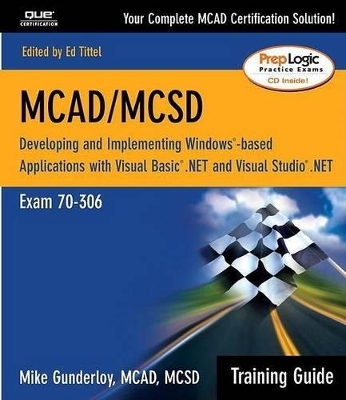
MCAD/MCSD Training Guide (70-306)
Pearson IT Certification
978-0-7897-2819-7 (ISBN)
- Titel ist leider vergriffen;
keine Neuauflage - Artikel merken
PLEASE PROVIDE
This certification exam measures the ability to develop and implement Windows-based applications by using Windows Forms and the Microsoft .NET Framework. This exam counts as a core credit toward the new MCAD (Microsoft Certified Application Developer) certification as well as a core credit toward the existing MCSD certification. Readers preparing for this exam find our Training Guide series to be the most successful self-study tool in the market. This book is their one-stop shop because of its teaching methodology, the accompanying ExamGear testing software, and superior Web site support at www.quepublishing.com/certification. The CD features the ExamGear product (test simulation with more than 150 test questions) and an electronic copy of the book.
Mike Gunderloy pursued his first Microsoft certification the year the program was introduced, and he has earned the MCP, MCT, MCSE, MCDBA, and MCSD credentials in the decade since. As lead developer for Lark Group, Inc., Mike has worked with small businesses and Fortune 500 corporations, and he has trained many other developers in the use of Microsoft products. He got hooked on computers when you still had to build your own out of parts, and he is still passionately interested in cutting-edge software technology. As a long-time member of the editorial staff of MCP Magazine, Mike has remained in close touch with the certification community.
(NOTE: Each chapter begins with an Introduction.)
Introduction.
How This Book Helps You. What the “Developing and Implementing Windows-Based Applications with Microsoft Visual Basic .NET and Microsoft Visual Studio .NET“ Exam (70-306) Covers . What You Should Know Before Reading This Book. Hardware and Software You'll Need. Advice on Taking the Exam.
Study and Exam Prep Tips.
Study Tips. Exam Prep Tips. Final Considerations.
I. EXAM PREPARATION.
1. Introducing Windows Forms.
Overview of the .NET Framework and Visual Studio .NET. Creating a Windows Application. Setting and Adding Properties to a Windows Form. Using Visual Inheritance. Event Handling. Building Graphical Interface Elements by Using the System.Drawing Namespace.
2. Controls.
Adding Controls to a Windows Form. Setting Properties of Controls. Handling Control Events. Dialog Boxes. Common Windows Forms Controls. Creating Menus and Menu Items. Creating Multiple-Document Interface (MDI) Applications.
3. Error Handling for the User Interface.
Understanding Exceptions. Handling Exceptions. Custom Exceptions. Managing Unhandled Exceptions. User Input Validation.
4. Creating and Managing Components and .NET Assemblies.
Creating and Managing .NET Components. Creating and Managing .NET Assemblies.
5. Data Binding.
Bind Data to the UI. Transform and Filter Data.
6. Consuming and Manipulating Data.
Access and Manipulate SQL Server Data. Access and Manipulate Data. Handle Data Errors.
7. Web Services.
Understanding Web Services. Creating Web Services. Discovering Web Services. Instantiating and Invoking Web Services.
8. Globalization.
Understanding Localization and Globalization. Implementing Localization for the User Interface. Converting Existing Encodings. Implementing Mirroring. Validating Non-Latin User Input.
9. Working with Legacy Code.
Using ActiveX Controls. Using COM Components. Using COM+ Components. Using Platform Invoke.
10. User Assistance and Accessibility.
Selecting a Help Compiler. Creating HTML Help 1.3. Creating HTML Help 2. Implementing User Assistance. Implementing Accessibility Features.
11. Printing.
Using the PrintDocument Component. Using the Printing Controls.
12. Testing and Debugging a Windows Application.
Testing. Tracing. Debugging.
13. Deploying a Windows Application.
Deployment Tools. Deploying a Windows Application. Shared Assemblies. Creating Installation Components. URL Remoting. Methods of Deployment. Windows Logo Program Requirements.
14. Maintaining and Supporting a Windows Application.
Managing a Windows Process. Working with Event Logs. Working with Performance Counters. Designing a Windows Application for Performance.
15. Configuring a Windows Application.
Configuring Control Licensing. Configuring a Windows-Based Application. Configuring Security. Configuring Authorization.
II. FINAL REVIEW.
Fast Facts.
Creating User Services. Creating and Managing Components and .NET Assemblies. Consuming and Manipulating Data. Testing and Debugging. Deploying a Windows-Based Application. Maintaining and Supporting a Windows-Based Application. Configuring and Securing a Windows-Based Application.
Practice Exam.
Exam Questions.
III. APPENDIXES.
Appendix A: Glossary.
Appendix B: Overview of the Certification Process.
Types of Certification. Certification Requirements.
Appendix C: What's On the CD-ROM.
PrepLogic Practice Tests, Preview Edition. Exclusive Electronic Version of the Text. Complete Code Samples.
Appendix D: Using PrepLogic, Preview Edition Software
Exam Simulation. Question Quality. Interface Design. Effective Learning Environment. Software Requirements. Installing PrepLogic Practice Tests, Preview Edition. Removing PrepLogic Practice Tests, Preview Edition from Your Computer. Using PrepLogic Practice Tests, Preview Edition. Standard PrepLogic Practice Tests, Preview Edition Options. Time Remaining. Your Examination Score Report. Review Your Exam. Get More Exams. Contacting PrepLogic. Customer Service. Product Suggestions and Comments. License Agreement.
Appendix E: Suggested Readings and Resources.
.NET User Assistance. Books. Web Sites
Index
| Erscheint lt. Verlag | 10.12.2002 |
|---|---|
| Verlagsort | Upper Saddle River |
| Sprache | englisch |
| Maße | 234 x 203 mm |
| Gewicht | 2041 g |
| Themenwelt | Informatik ► Betriebssysteme / Server ► Windows |
| Mathematik / Informatik ► Informatik ► Programmiersprachen / -werkzeuge | |
| ISBN-10 | 0-7897-2819-2 / 0789728192 |
| ISBN-13 | 978-0-7897-2819-7 / 9780789728197 |
| Zustand | Neuware |
| Haben Sie eine Frage zum Produkt? |